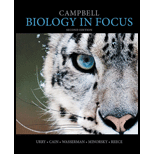
SYNTHESIZE YOUR KNOWLEDGE

How do cats drink? Scientists using high-speed video have that cats use an interesting technique to drink aqueous substances like water and milk. Four times a second, the cat touches the tip of its tongue to the water and draws a column of water up into its mouth (as you can see in the photo), which then shuts before gravity can pull the water back down. Describe how the properties of water allow cats to drink in this fashion, including how water’s molecular structure contributes to the process.
Want to see the full answer?
Check out a sample textbook solution
Chapter 2 Solutions
Campbell Biology in Focus (2nd Edition)
Additional Science Textbook Solutions
Biological Science
Laboratory Experiments in Microbiology (11th Edition)
Human Anatomy & Physiology (2nd Edition)
Anatomy & Physiology: The Unity of Form and Function
Microbiology with Diseases by Taxonomy (5th Edition)
Campbell Biology: Concepts & Connections (9th Edition)
- Test Your Understanding Know and Comprehend 11. Which of the following cannot function as a buffer? (a) phosphoric acid, a weak acid (b) sodium hydroxide, a strong base (c) sodium chloride, a salt that ionizes completely (d) a and c (e) b and carrow_forwardManufacturers make carbonated drinks by forcing pressurized carbon dioxide gas into flavored water. A chemical reaction between water molecules and some of the CO2 molecules creates hydrogen ions (H+) and bicarbonate, which is a buffer. In your opinion, is this reaction likely to raise the pH of a soda above 7, or lower it? Give your reasoning.arrow_forwardDiscuss Concepts You place a metal pan full of water on the stove and turn on the heat. After a few minutes, the handle is too hot to touch but the water is only warm. How do you explain this observation?arrow_forward
- Your friend argues that all water conducts electricity, regardless of what it contains. You prepare three liquids to test this hypothesis: one with deionized water (with no solutes, only water molecules), one with 5% glucose in water, and one with 5% sodium chloride in water. Which of these solutions, if any, will conduct an electric current? Explain.arrow_forwardExplain why a water strider insect can walk on the surface of a lake or pond. Use the terms hydrogen bonding, cohesion, and surface tension in your response.arrow_forwardChemistry 1. Calculate isoelectric point of asp, leu, tyr, his and lys. 2. Why do the pK values of ionizable groups differ between free amino acids and amino acid residues in polypeptides? 3. List some covalent modifications of amino acids in proteins. 4. generic amino acid and identify the α carbon and its substituents.arrow_forward
- 8. A drug company wants to design a pill that will dissolve when placed in water but will not dissolve when exposed to fats. Based on what you know about water and fat, describe the characteristics a pill must have to dissolve in water but not in fat.arrow_forwardLiving beings are made of organic and inorganic substances. According to the complexity of their molecules how can each of those substances be classified?arrow_forwardCeramides work in tandem with cholesterol and saturated fatty acids to give your skin water impermeability. Explain how the structure of these types of molecules would in fact lead to skin being water-impermeable.arrow_forward
- explain the chemical reaction that occurs water molecules dissociate and reform. why is these chemical reactions the basis of the pH scale?arrow_forwardWhich is not a property of water? a. Low specific heat b. Hydrogen bonds form a lattice c. Separate into ionsarrow_forwardIn Mrs. Frizzle’s science classroom, she sets up a beaker as shown in the illustration shown; there is a bag filled with a glucose solution (glucose and water) within a beaker of the same solution at a different concentration. The bag is permeable to water but not glucose. One student, Ricky, is working on the problem and draws his arrow showing the movement of water into the bag. Another student, Cindy, disagrees with him. Cindy says the arrow should be showing the movement of water out of the bag. Which of the two students is correct? Explain why.arrow_forward
 Biology (MindTap Course List)BiologyISBN:9781337392938Author:Eldra Solomon, Charles Martin, Diana W. Martin, Linda R. BergPublisher:Cengage Learning
Biology (MindTap Course List)BiologyISBN:9781337392938Author:Eldra Solomon, Charles Martin, Diana W. Martin, Linda R. BergPublisher:Cengage Learning Biology: The Dynamic Science (MindTap Course List)BiologyISBN:9781305389892Author:Peter J. Russell, Paul E. Hertz, Beverly McMillanPublisher:Cengage Learning
Biology: The Dynamic Science (MindTap Course List)BiologyISBN:9781305389892Author:Peter J. Russell, Paul E. Hertz, Beverly McMillanPublisher:Cengage Learning Human Biology (MindTap Course List)BiologyISBN:9781305112100Author:Cecie Starr, Beverly McMillanPublisher:Cengage Learning
Human Biology (MindTap Course List)BiologyISBN:9781305112100Author:Cecie Starr, Beverly McMillanPublisher:Cengage Learning Anatomy & PhysiologyBiologyISBN:9781938168130Author:Kelly A. Young, James A. Wise, Peter DeSaix, Dean H. Kruse, Brandon Poe, Eddie Johnson, Jody E. Johnson, Oksana Korol, J. Gordon Betts, Mark WomblePublisher:OpenStax College
Anatomy & PhysiologyBiologyISBN:9781938168130Author:Kelly A. Young, James A. Wise, Peter DeSaix, Dean H. Kruse, Brandon Poe, Eddie Johnson, Jody E. Johnson, Oksana Korol, J. Gordon Betts, Mark WomblePublisher:OpenStax College



